We occasionally link to goods offered by vendors to help the reader find relevant products. Some of these may be affiliate based, meaning we earn small commissions (at no additional cost to you) if items are purchased. Here is more about what we do.
The idea of edible plants usually conjures up thoughts and images of fruits, vegetables, and herbs – everyday ingredients we love to eat.
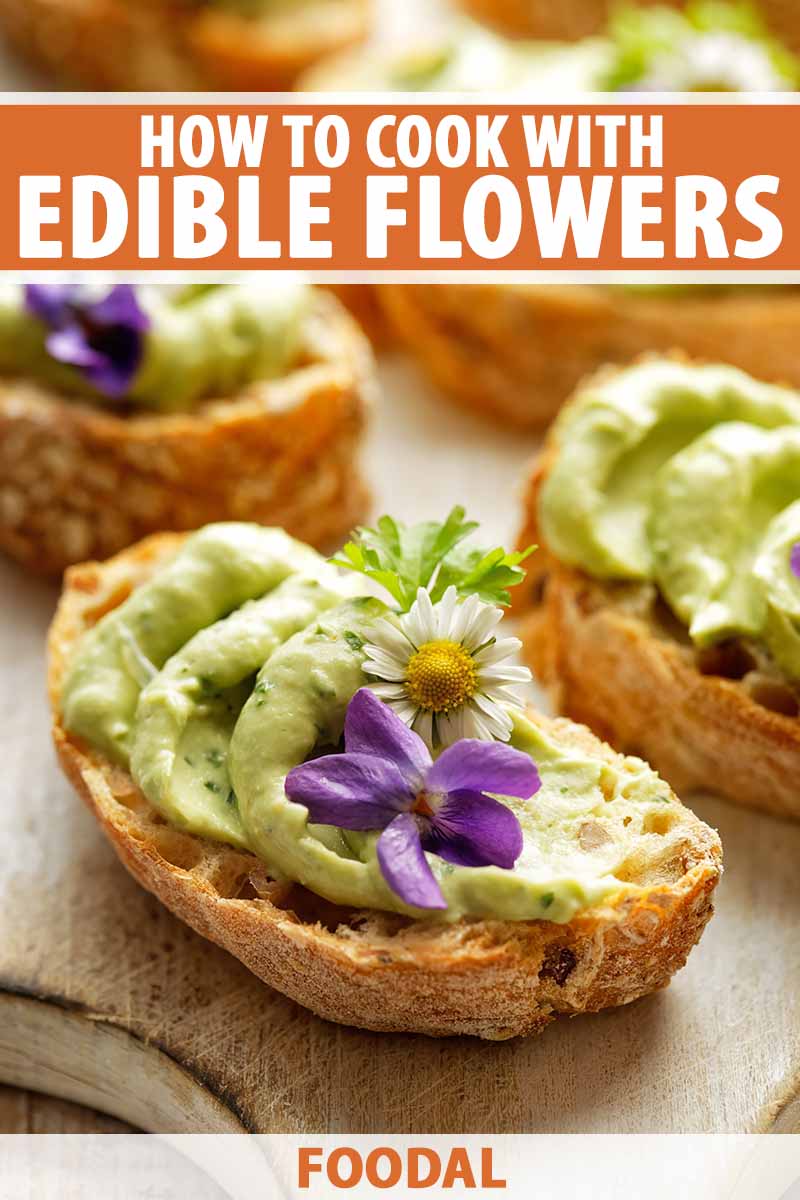
But you might not be aware that there are dozens upon dozens of flowers to bring to the feast, too, and not just to display as pretty centerpieces!
Did you know that you can eat many types of beautiful blossoms?
Edible flowers have a stronghold in the culinary world – veggies like broccoli, cauliflower, and artichokes are botanically flowers or buds.
But many still don’t realize you can incorporate brightly colored blooms often found in outdoor beds, gardens, and pots into your meals.
Before you start plucking petals to add to your garden salad, though, educate yourself. Not all blooms are edible, and some are poisonous if ingested.
Let’s go over some of the varieties you can transition from a homegrown bouquet to your plate, and how you can start incorporating them in your cooking and baking!
How to Add Edible Flowers to Your Cooking
The Best Edible Flowers
There are so many common edible blossoms. But what exactly can you choose as safe, non-toxic options?
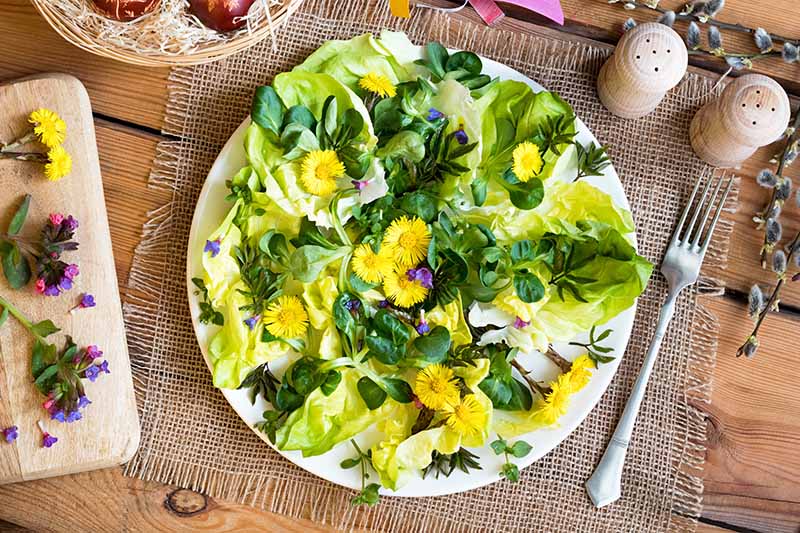
Here are some of the highlights that you may already have growing at home, in your own garden:
- Bachelor’s Button
- Borage
- Calendula
- Camellia
- Carnation
- Chamomile
- Clover
- Coneflower
- Dandelion
- Daylily
- Elderflower
- Fuchsia
- Gardenia
- Geranium
- Hibiscus
- Honeysuckle
- Hosta
- Impatiens
- Jasmine
- Lavender
- Lemon Verbena
- Lilac
- Magnolia
- Marigold
- Mint
- Nasturtium
- Pansy
- Passionflower
- Peony
- Rose
- Rosemary
- Sunflower
- Sweet Alyssum
- Violet
- Zinnia
Do you see any on this list that are a surprise to you? Maybe you didn’t know your marigolds and magnolias could be tasty treats?
For the best appearance and quality, pick them fresh soon before you will be preparing your meal, as they wilt quickly!
For a more extensive list with photos and detailed descriptions of each one, visit our sister site, Gardener’s Path.
If your curiosity is now piqued, let’s move on to gain some creative and tasty ideas to use when preparing a meal!
Herbal Varieties
The herbal buds and blossoms in your herb garden provide a resource for numerous edible delicacies.
They are an easy choice for gorgeous garnishes on top of anything and everything you are serving, but their application can certainly go beyond a final beautiful topping.
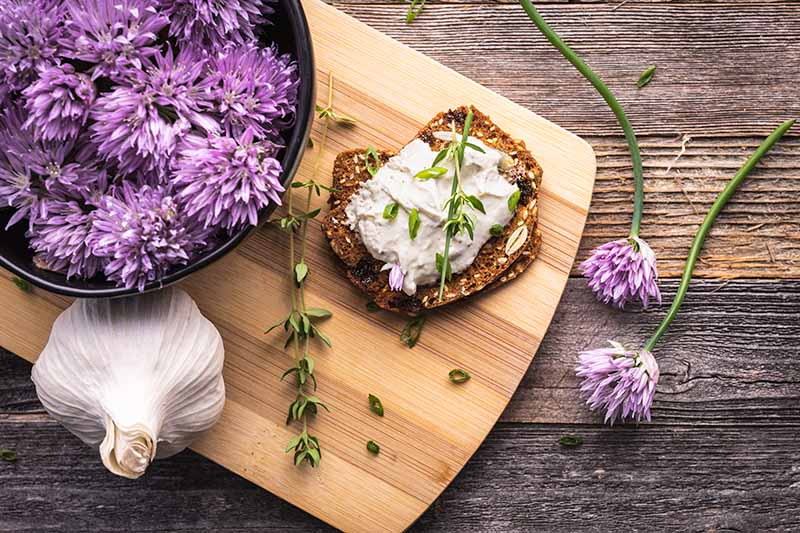
The blooms are typically milder in taste than the leaves, and can work well to subtly season recipes that don’t require any cooking.
For example, use the petals from chives, lavender, rosemary, basil, and sage for mixing into vinaigrettes for salads, or to top chilled panna cotta.
You can also make homemade shrub mixers, perfect for mocktails and cocktails.
Herbal options are also useful for different cooking and baking techniques, such as adding rosemary blossoms to your bread dough or sage blossoms to savory dishes featuring lighter meats like chicken breast, seafood, and pork.
Infuse them into purees, sauces, and custard bases like ice cream or frozen yogurt, crème brulee, and pudding.
The gentler onion flavor of chive blossoms adds depth to broth, giving soups a boost of flavor when mixed in immediately before serving.
Make your homemade cakes stand out by adding a small amount of finely chopped lavender blooms to the batter or frosting.
We suggest you use any of these kinds sparingly – at least at first – as too much can cause a perfume-heavy taste and aroma, particularly in the case of lavender!

Lavender Cookies – Get the Recipe Now
Approach more unfamiliar blooms with some careful discipline – test any new recipes by taking note of how much you add to your first batch, starting with just a few teaspoons depending on what you are cooking.
Once you have a taste of the final result, make your adjustments for the next time you make the same recipe.
Using herbal buds and blossoms gives you an opportunity to create a landscape of aromatic taste and aromas for your meals that can carry from the first course to the last – your soups and salads can carry the hint of the herbal flavorings, and the stronger flavors from the leaves are present in the main course.
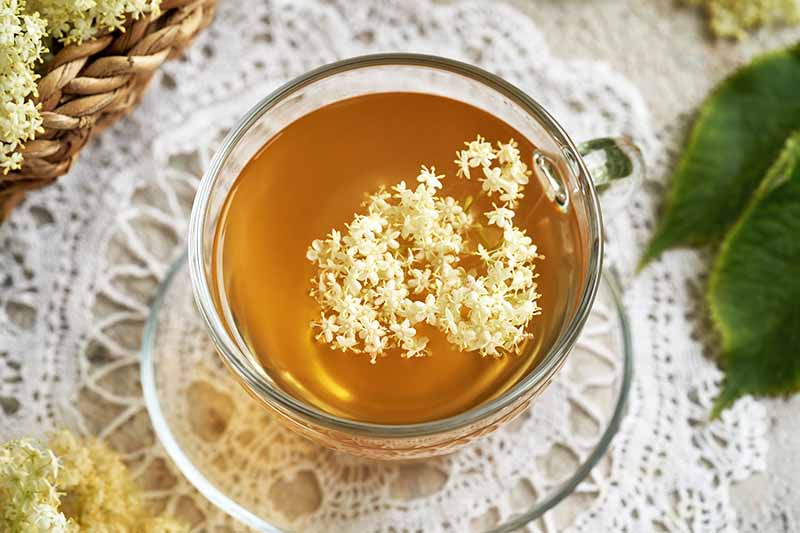
Imagine an outdoor summer dinner party, serving a fresh mixed greens salad garnished with tiny rosemary blooms presented in a gorgeous wooden serving bowl followed by roasted chicken seasoned with rosemary leaves served with roasted potatoes mixed with sage blossoms.
And with creme brulee infused with chamomile for the final dessert, and perhaps some warm mint and lemon verbena tea for the final drink, you’ll have the perfect seasonal multi-course meal!
Vegetable Blossoms
When you are growing a variety of fresh vegetables in your home garden, chances are you’ll have one or two unexpected edible blossoms to try!
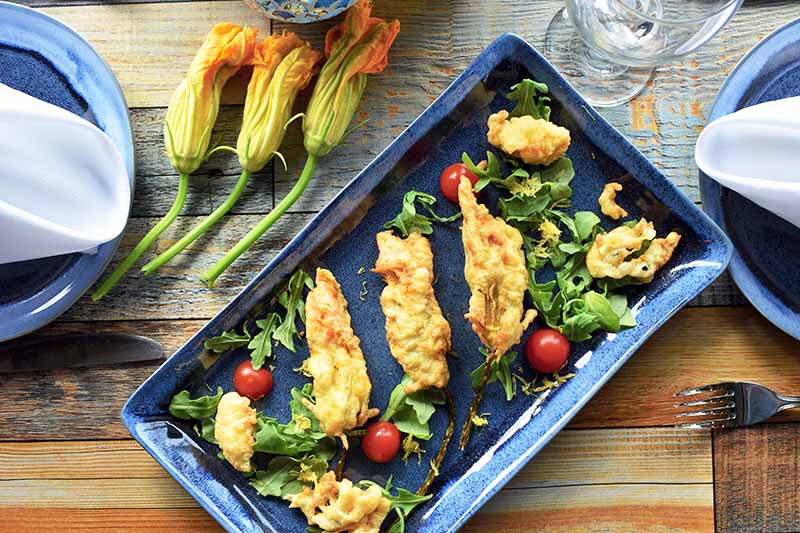
The zucchini flower is one of the more well-known edible types and it comes from a very prolific type of squash!
If you know your garden will produce too much zucchini in the summer season, or any variety of summer squash for that matter, this is your perfect opportunity to seize some of the blossoms, and utilize them in your well-crafted cookery.
The squash blossom has a delicate, herbal flavor to it. It can be prepared raw, sauteed, or mixed into soups and sauces.
It can also be stuffed with a fresh ricotta cheese mixture, dipped in a light batter, and deep fried for a bold and colorful appetizer.
Remove the stamens and pistils from each one when preparing them for cooking, and trim the stem. Other edible vegetable blossoms include pea and bean blossoms, radishes, yuccas, and the hibiscus-like blooms of the okra plant.
These, like the herbal varieties, are milder in flavor, and are ideal for use as garnishes, or in salads and other raw preparations.
Garden Blooms
Gorgeous garden blooms – they beautify any blank space, filling our yards and homes with breathtaking colors and heavenly aromas.
Many of them can also be enjoyed in recipes. We’ll focus on just a few basics here!
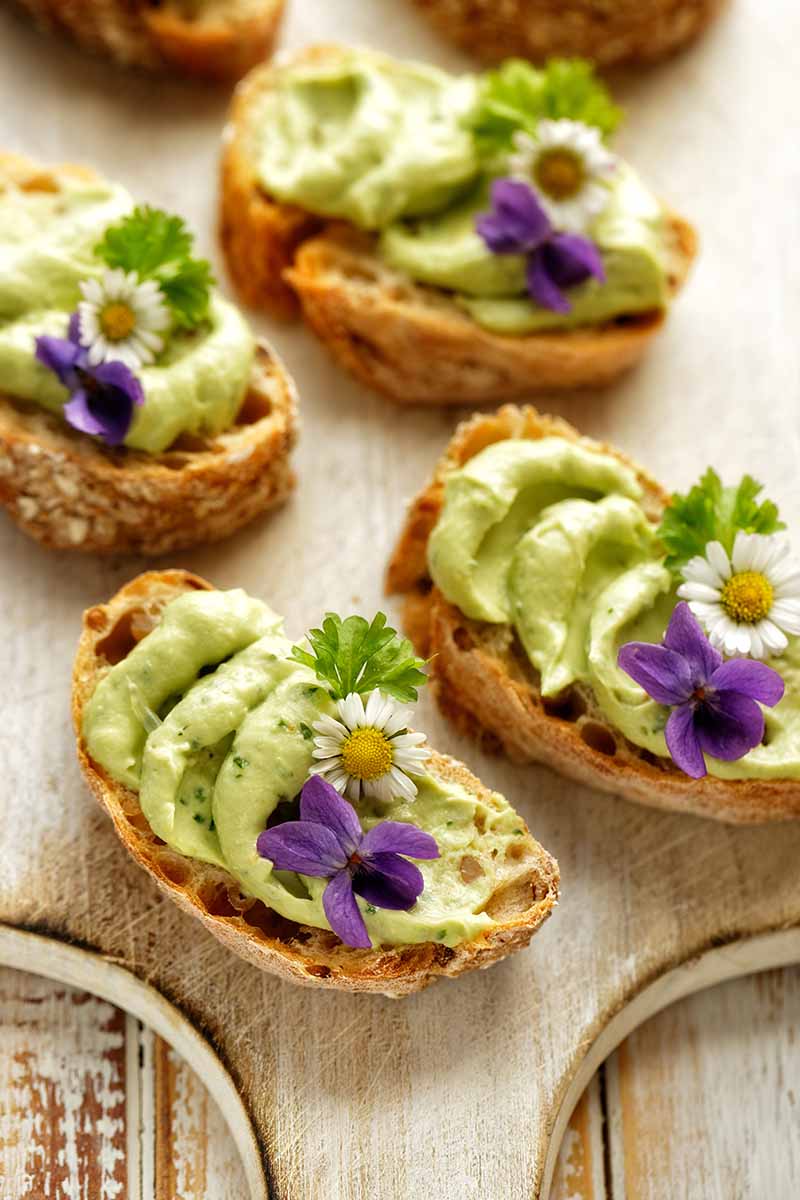
Just like you might with the buds and blossoms from classic herbs that are allowed to bloom, you can use many types of garden flowers to garnish a wide range of dishes and desserts.
To start, you can elevate basic cupcakes or budinos with the most beautiful sugared creations, like marigolds or violets!
Hibiscus blooms have a fruity and acidic flavor, similar to how a cranberry tastes. Pair them with juicy orange segments and butter lettuce for a delightful summer salad.
You might also like to infuse them in hot water for a caffeine-free tea. Keep in mind that hibiscus tea is made with a specific species of hibiscus, H. sabdariffa, also known as roselle.
Honeysuckle blossoms are sweet, as are impatiens, while pansies are more grassy and earthy in flavor. The flavors are all quite mild, and should be combined with other delicate food items, or used as a simple, natural garnish.
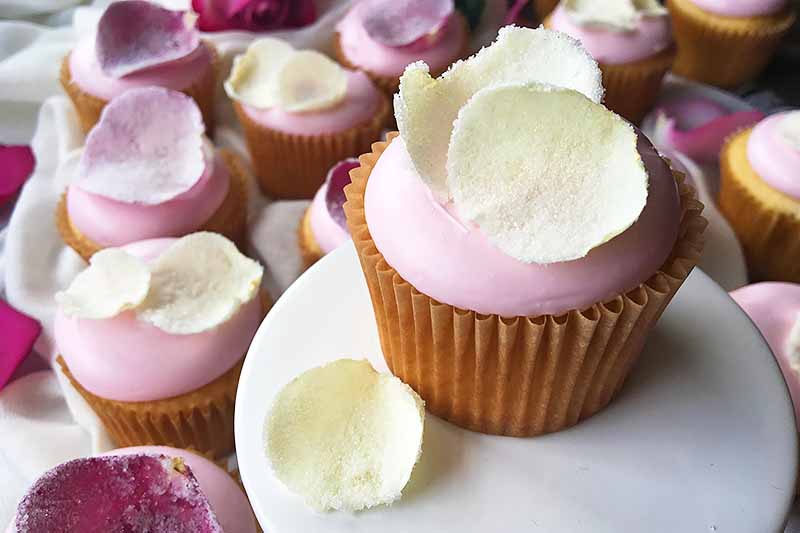
Sugared Flowers – Get the Recipe Now
The rose offers a wide range of flavors, from fruity to spicy! The type of rose, the growing conditions, and even the color may all factor into the final flavor of rose petals.
Use roses for salads, garnishes on top of your favorite homemade ice cream, and in syrups, jellies, and punches.
Still a little hesitant to incorporate these types into your recipes?
Erin French, head chef and owner of The Lost Kitchen in Freedom, Maine, loves adorning her dishes with edible garden blooms, and incorporating them in creative ways into recipes. They are heavily featured throughout her menus dedicated to seasonal and local cuisine.
Erin French’s “The Lost Kitchen: Recipes and a Good Life Found in Freedom, Maine,” available on Amazon
French offers the perfect inspiration if you’re trying to think of playful ways to use an edible array of buds and blossoms. To study her cooking techniques and philosophies, and to view some beautiful food photography and styling, her cookbook, “The Lost Kitchen: Recipes and a Good Life Found in Freedom, Maine,” is available to purchase now on Amazon.
What to Avoid
A word of caution: not all blooms are edible!
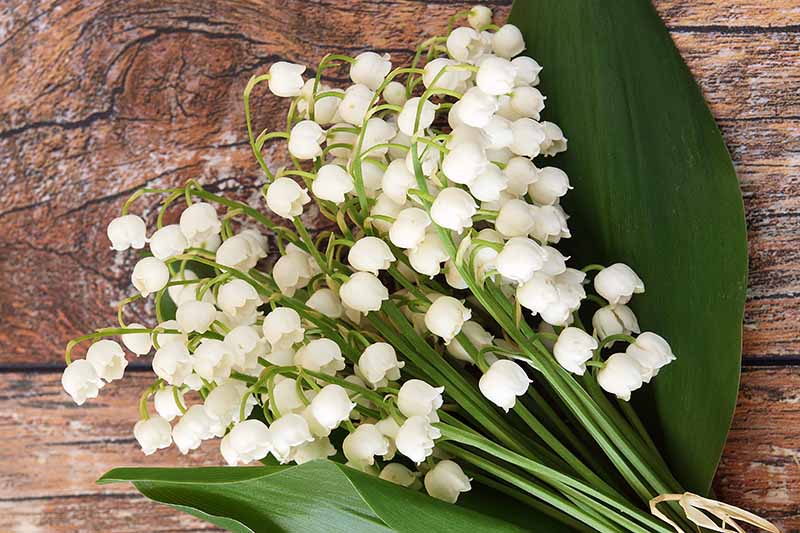
Flowers bring varied levels of flavor and texture to your dishes, as well as visual delight. But this ingredient should be used with careful trepidation.
Some common plants that are toxic to humans and animals include:
- Amaryllis
- Anemone
- Azalea
- Castor Bean
- Clematis
- Daffodil
- Easter Lily
- Foxglove
- Hydrangea
- Iris
- Lantana
- Lily of the Valley
- Oleander
- Stargazer Lily
- Sweet Pea
- Water Hemlock
- Wisteria
Gardener’s Path provides additional detail on many of these common plants, if you want to further educate yourself on what exactly to avoid and how to identify them.
Even among the varieties we have listed here as safe, you should proceed with caution. Never use any blossom that has been exposed to pesticides, herbicides, or other chemical treatment.
And some options may also be dyed to a vibrant color – definitely avoid those as well!
If you don’t grow your own at home, obtain them from a reputable source.
Introduce them one at a time into your cooking. Those with allergies or sensitivities may react badly to some varieties, even if the herb or vegetable doesn’t cause a reaction.
Don’t be put off by the need for caution, however! With a little research and advance planning, you can add color, beauty, and exciting new flavors to your homemade cuisine, and enjoy using the plants you’ve lovingly tended in your garden in fun new ways.
A Bountiful Bouquet of Flavors
We are so excited for you to embark on your own aromatic adventures using edible flowers!

As long as you are educated on the varieties that are safe and edible to eat, and you begin by introducing them into your diet gradually, you will have so many colorful opportunities for creating visually stunning and uniquely flavored food experiences.
Experiment with the edible blossoms growing in your garden, and have some fun with this new discovery!
Do you know which types from our list you want to start incorporating into your recipes? Were there any described here that you were not expecting to see, maybe some that you have been planting or growing for years? Leave a comment below!
Inspired to find other fun ways to make deliciously stunning dishes? You’ll find some other nifty ideas in our collection of how-to articles. Get playful with the following tutorials:
- 5 Steps to Create the Perfect Meat and Cheese Board
- An Easy Frosting-Free Way to Decorate Cupcakes
- How to Blanch Almonds
Photos by Fanny Slater and Nikki Cervone, © Ask the Experts, LLC. ALL RIGHTS RESERVED. See our TOS for more details. Uncredited photos via Shutterstock. Product photo provided by Amazon. Originally published on September 2, 2014. Last updated on June 29, 2023.
About Nikki Cervone
Nikki Cervone is an ACS Certified Cheese Professional and cheesemonger living in Pittsburgh. Nikki holds an AAS in baking/pastry from Westmoreland County Community College, a BA in Communications from Duquesne University, and an MLA in Gastronomy from Boston University. When she's not nibbling on her favorite cheeses or testing a batch of cupcakes, Nikki enjoys a healthy dose of yoga, wine, hiking, singing in the shower, and chocolate. Lots of chocolate.




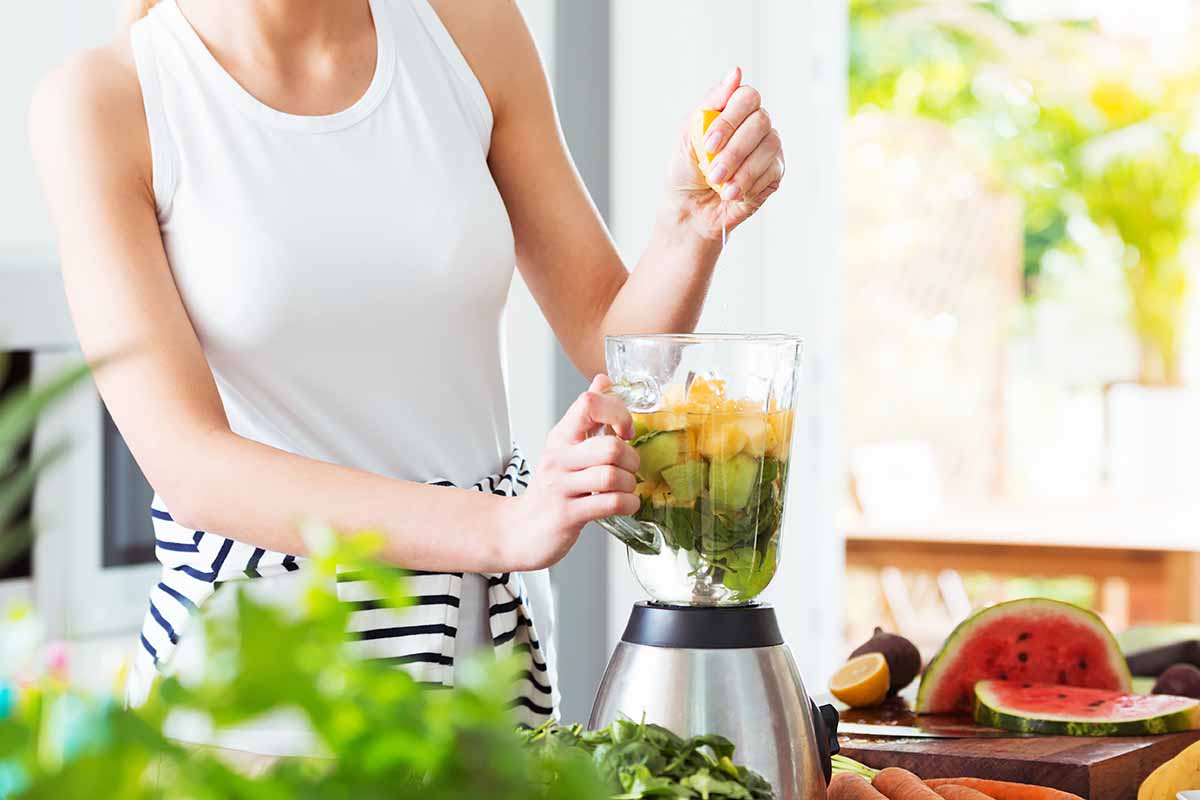

Ahhh. The best part of growing your own squash is deep frying the blossoms! They are just so delicate and tasty!
My mom grows nasturtiums and puts them on salad. They are sort of peppery and add great flavor and color. I used to eat sweet pea flowers when I was a kid, but it turns out I probably shouldn’t have! Ack!
Such a pretty post, Lynne!
Thanks, I love the colors in these pictures.
I cannot say I’ve ever eaten any edible flowers- that I know of. The idea is a little daunting to be quite honest. Its sort of like with mushrooms- as much as I love them- I’m always afraid of trying those I don’t know.
What kind of taste do they have? I’d always thought it would be a grassy bitter taste, but obviously not.
And more importantly, how do you know which blooms are edible? Other than googling them?
Torreyy,
The garden types usually taste like a less pronounced version of vegetable that they grow into. The roses, lilacs etc. give taste similar to the smell but less pronounced – I wouldn’t use too much of these as they can be a bit overpowering in abundance.
Also, there is a link at the bottom of the article that goes to a University of North Carolina extension page that lists many of the known varitiess of edibles.
The dish with the blossoms really do look nice though. I think my curiosity is going to get the best of me here. I’m going to have to give edible flowers a try.
Zucchini and pumpkin blossoms are probably the only edible varieties I feel comfortable with because I’ve been eating them since I was a child. I always get them at the farmers’ market. Next time I go, I’ll look for other types they might have. Thanks to your post, I now know what to look for :).
As much as I would love to try this with my salads, I am not sure if I could. I will have to do some research before I try this out because I have allergies to pollen. I am not sure if pollen would make them flare if I were to ingest the flower whole. I have to take a few pills throughout the spring and summer and wear a mask when I mow the yard. If I don’t my eyes will swell twice their regular size and my nose will itch for days. I love the presentation and the color the flowers bring to the dishes though. It is very creative.
Right. I have terrible allergies, so I’ll have to check this out too. I’ve always wanted to put edible flowers on cakes, but I’ve been kind of afraid to try it. Just working with the flowers would probably give me fits in the first place, but if I can figure it out that would be great.
I have seen some gorgeous dishes and cakes with edible flowers. What a fantastic way to dress up a meal.
The photos here are so beautiful, it makes me want to try this even more.
This is an absolutely beautiful way to spice up your salad. I think I have to give this a shot. I’m going to have to keep an eye out for some flowers. I’ve actually been pretty bored of salad lately. Does anyone else feel that way? This is a breath of fresh air for me.
I’ve never tried edible flowers, except for honeysuckle where you take the stem out and suck the nectar out through the bottom. Though that’s only the nectar and not the plant itself. I’ve been told you can’t eat tomato flowers because they’re ”poisonous”. Irony is, you would probably need to eat a kilo of them to get poisoned by the plant. I’ve looked around and there’s no definitive answer. Anyone up for being a lab rat?
NyxKitty,
Tomatoes blossom are PROBRABLY harmless since the mature into fruit but I’d be a little leery. Tomatoes are a member of the nightshade family and the leaves are somewhat toxic. Same goes with potatoes…even green skins on these have some poisons.
Yum! These look and sound so delicious. It’s no different than eating lettuce or vegetables, they just happen to look and smell a little prettier. 🙂 I’ll definitely look into this some more.
Squash blossoms are a new favorite of mine. This past summer I saw them on so many tasting menus and was intrigued because I not only had never heard of them but was convinced I wouldn’t like them–I was wrong and loved them. I first had them with an herbed sheep’s milk ricotta filling and they were out of this world. I like adding edible flowers that are colorful to my salads because the presentation can’t be beat, but I think my absolute favorite addition is a chive flower because the flavor is explosive. Great pictures with this post, so vibrant!
I was part of a cookery class last year that covered different flowers and we tried out some basic recipies. I love drinking rose flavored drinks.
Great job on this post, it looks awesome and has some really useful information. I have shared it with the leader of the class I attended.
Thanks for sharing this lovely idea! I have been hearing this before but at times, I am uncertain with the flowers that can be consumed safely as not are all edible. Flowers add so much to the appearance to the dishes as well as its scent, and I am now inspired to try flowers in my cooking!
I had no idea that there are edible flowers out there…glad to be informed, might i add that the pictures above are adorable yet amazing :)…looking forward to incorporate what i have learnt here to my meals 🙂
What a wonderful idea! I never thought about edible flowers, they make the food look so fun.
Also the photos of in this post are beautiful. =)
I feel like edible flowers has been a hot topic lately. I just found out that a local botanical garden in my area is offering cooking classes focused on edible flowers. I think the topic sounds fantastic and I plan on signing up myself. It would be a lovely skill to add to any chef’s repertoire.
I’ve never had the pleasure of eating edible flowers before and it seems fun. There was an episode of Anthony Bourdain’s new show where he visited an acclaimed chef in Copenhagen who used lots of flowers. What drove me nuts about the episode though, is nobody described the flavors! I am so grateful of the link you posted to NC State University. They list all the flavors and I cannot wait to try some myself!
When I was a growing girl, my Mother would make Petit Fours for a snack on Saturdays, for us. Incorporating edible flowers is such a sweet touch for a dessert. I will surprise her with a edible flower salad for lunch on tomorrow.
How nice that your mom did that for you. Those things can be a handful to make. Also, how very sweet that you want to return the favor now. I’m sure she will just love it.
I know someone who owns a bed and breakfast that serves proper tea and throws tea parties. I’ll have to see if she’s onto edible flowers. What a perfect touch they would make for her delicate treats.
I have never thought about eating flowers before. I mean I used to try and eat them when I was younger, but that never ended well. I got yelled at quite often because of it. Maybe that’s why I didn’t know that they were edible for years.
My mother lied to me.
I might have to try this. Adding edible flowers to my cooking sounds really interesting and really fun. I’m not sure where to start with this but I’ll have to read further. I might start with adding them to my salad and then go from there.
I’ve only eaten a few flowers – nasturtiums in salad, lavender in cakes & ice cream and rose in drinks. I know there are many more but just never think of doing the research and harvesting at appropriate times…
This does remind me of a story though. Some yeas ago, I organised a group to have lunch in a restaurant for my Mum’s birthday. I had been in early and given them a special cake with smooth chocolate icing sprinkled with some lavender flowers – stylish I thought. When the cake was brought out to surprise Mum, I got a bigger surprise as they had wiped off the flowers and sifted icing sugar all over my beautiful cake! It looked amateurish and nowhere near as special as I had worked so hard for. Obviously they didn’t recognise the beauty and edibility of lavender flowers!
I saw your cover picture for this article and I thought to myself, “No way!” That salad looks absolutely incredible. I had no idea that there were edible flowers! Every other salad pales in comparison to this. My husband gets pretty nasty allergies though, so we’ll have to start slow over here. I’ll have to experiment on which flowers do best together and in what. Hopefully I’ll be adding a few of these to my garden next year!
Hah, my friends dad always used to put these delicious purple flowers into my salads when I was younger. The first time he did it, I thought he was crazy, the next times, I would ask for them.
Glad to see this article is out there to let everyone know how great flowers can taste!
Thanks heaps Lynne, you’re a gem ^_^
Interesting. I can’t say I’m convinced with eating flowers though! I already eat quite a bit of leaves (cabbage,spinach,lettuce) and berries. Maybe if I’m doing a special dish I might make a “special ingredient” some flowers to throw people a bit!
Hmmm eating flowers. It’s hard to imagine them as an edible food source, however, the picture you posted of the edible vegetable blossoms look delicious! I can definitely see myself trying any types of vegetable-related blooms. The types that look like normal flowers would be great for presentation and then to top it off, you can eat too! One of my sisters is very allergic to pollen though, I’m not sure what would happen if she ate it.
I can’t say I’ve ever eaten these flowers before and would be interested to know what they taste like. They do look great as a garnish though – they make the meals look really special.
When I was younger I used to go around to find Lemon Clovers (or Oxalis Stricta). In retrospect, I knew nothing about whether this was a poisonous plant. All I knew was that they were delicious & no one wanted to join me in eating them. Later I learned that excessive amounts of it are unhealthy and can lead to digestive issues and or kidney problems. So, I’m glad you mentioned that we should be knowledgeable AND exploratory.
One of my favorite restaurants used to sprinkle petals onto certain of their pizzas as a garnish. I believe they were nasturtiums. I always thought it was a lovely touch, but sometime within the past few years they’ve stopped. This post makes me wish they’d start again. Maybe I’ll look into the guide provided and start growing my own, I love the idea of garnishing soups and salads with edible flowers.
I love the pictures in the article, and the idea of eating flowers. I agree with Torreyy, though, it does seem a bit scary. I have seen recipes and pictures of cakes with fresh flowers on top, and they look absolutely beautiful, though, so it might be worth it for me to take a chance on this, as long as I’m the only one eating them. I do eat wild raspberries at the park, and have also tasted the wild onions along the trails where I walk, so this wouldn’t be too much of a stretch.
Oh! I’ve always wondered about zucchini flowers! And now that I see the salad picture — wow, this looks beautiful and colorful!
You talk about flowers in rosemary, I have a question — I read we should harvest the herb before the flowers come on. How does this change the way we should have flowers as food?
I’ve known about the idea of adding edible flowers to cooking for some time but never heard anything past the term “edible flowers”. This is the first place I’ve ever seen an actual article on them. I bet a lot more people would be willing to grow and add these to their cooking if they were directed to this website! Thank you for mentioning several flowers throughout the article that are edible as well. I didn’t know that most of these could be consumed.
I’m not too sure whether I’m fully sold on the idea of actually eating flowers, but it is interesting to learn more about it nonetheless. Thank you for sharing.
I’ve been thinking for quite some time to add flowers to dishes. I haven’t tried it yet though. Edible list below;
Rose
Tulip
Chrysanthemum
Yucca
Lavender
Allium
Angelica
Arugula
Carnations
Marigold
Borage
Bee Balm
Basil
Bachelor’s Button
Anise Hyssop
Violets
sunflower
Squash & pumpkin
Sage
Rosemary
Radish
Pansy
Rosemary
Oregano
Nasturtium
Mint
Lilac
Lemon berbena
Holly Hock
Johnny Jump up
Jasmine
Impatiens
Dandelion
English daisy
Fennel
Fuchsia
Gladiolus
Hibiscus
Chicory
Cilantro
Clover
Citrus fruit flowers
Chervil
I’ve always wanted to grow a herb garden for going together with my cooking, but I didn’t know you could actually use flowers! It would certainly make the dish very pretty to look at and it would give the food more variety in taste. I wonder which flowers would go well with roasted meat, though…
I’ve always thought that eating flowers is a bit crazy, haha. Probably because I still remember the disgusting taste of viola tricolor that I had to drink for my skin problems. You made me reconsider my opinion on edible flowers. But now that I think about it, sweets made from rose are delicious! I’ll have to say that they look definitely look dreamy, mixed into a salad.
I always watch cooking shows that use edible flowers but I’ve never actually seen them in grocery or speciality stores. This article is an interesting read. If I hadn’t watched cooking shows I would have never thought to use flowers in my food. It definitely does make any dish more appealing.
This is such an adorable idea! I had honestly never even considered this before, but it looks so attractive! The hibiscus blooms with orange slices sound like they would be so delicious, and would be perfect for the summer.
Thank you for this information, I was so excited to see this article! I remember actually seeing some flowers in a plastic container alongside of some fresh herbs at an upscale grocery store once, have seen them used to decorate cakes, and saw an article in a magazine sometime B.I. (before internet) indicating some different uses and what can be used. This was a beautiful idea, but I could no longer remember which ones could be used this way safely, and it never seemed to cross my mind at a time that it was convenient to research. I was thrilled to find a lavender bush in the backyard of the house I bought a couple of years ag (which I love!) but to find out today that it is not only edible and but can be used with chocolate? It is almost too much! 😀
Deep fried courgette (zucchini) flowers are very popular in France – stuffed, as you say, with cheese. Nasturtiums are my favourite on a salad.
I remember that me and my family once ate in a restaurant whose dishes all have flowers. Yes, all. And it’s so amazingly delicious~ I first thought that the flowers were just for decoration, or that even if they’re edible, they probably have no taste. But I was wrong. Sure, some flowers didn’t have much taste, but all in all, they added to the delicious taste of the dish. Now that I think about it, I want to revisit that restaurant <3
Just a question though, if I were to grow a flower, how would I know if it's the edible breed or not?
This is so interesting! I haven’t really heard anything about adding actual flowers to a formal meal. The 6 years old me would be really excited right now.
I really liked the salad recipe, I think that flowers can add this special touch when it comes to flavor and aesthetic. I can definitely picture myself picking flowers for the salad on a spring picnic.
Thank you so much for sharing! 🙂
A grocery store near where I grew up used to sell packs of edible flowers, The little girl in me loves them! I love nasturtiums and chrysanthemums, especially chrysanthemum tea (which is hard to find outside Chinatown). I love rose jams, candies…anything! Rose syrup is available at Indian grocery stores, as is rose water and orange blossom water, and they work great in desserts. Maybe you can even make ice cream from them; I’ve never tried, but it sounds delicious.
One question: if I wanted to make flower waters, such as lavender water, rose water, orange blossom water, etc., how would I go about doing that? Just add flowers to a container of water, seal, and wait, or do you have to add something else?